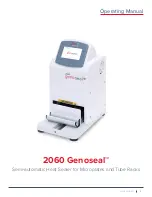
Operating Manual
8
1300-87075-1A
Optimization
The Genoseal has been designed to reliably seal plates of different heights and different plastics, using a variety
of films, to give a seal with varying properties. These components will require different sealing conditions.
The quality and strength of the seal created between the sealing film will vary with different conditions. In
general, increasing either the sealing temperature or duration of seal, gives a stronger, more complete seal.
However, over-sealing on a regular basis is not recommended, as applying more heat can cause excessive
damage to the plate being sealed. This, in turn, would reduce the number of times a particular plate can be
resealed. Therefore, a balance has to be achieved, giving an acceptable seal with the minimal plate damage or
distortion.
Another optimization factor to be taken into account is the surface area of the plate. A plate with thin raised rims
around each well will have a reduced surface area, compared to a plate with wide raised rims. This would mean
that less heat is needed to seal the thin rim plate in comparison to the wide rim.
The pressure that the heater plate exerts during sealing is pre-set and cannot be adjusted. Plates that do not
have any raised rims are not usually suitable for heat-sealing.
Temperature and Time Setting
The following table gives a guideline as to the sealing temperature and time for different materials.
PLATE MATERIAL
TEMPERATURE SETTING (ºC)
TIME SETTING (SECONDS)
Polystyrene
145 to 165
2 to 5
Polypropylene
150 to 175
2 to 5
Polyethylene
150 to 170
2 to 5
Sealing PCR Plates - No Skirt, Half Skirt
An adapter will be required to seal plates which have well bottoms protruding past the plate skirt as well as
plates with no skirt. This is available from Spex.












